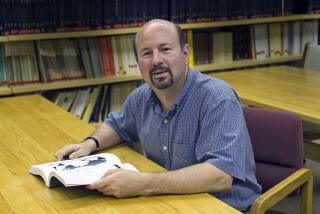He’s Out in Left Field, but Often Right
- Share via
Free Radical: Albert Szent-Gyorgyi and the Battle Over Vitamin C by Ralph W. Moss (Paragon House: $22.95; 295 pages)
By one definition, truth is what everybody agrees is true. Perhaps that sounds too weak--we like to think truths have a truth that is independent of a popular vote--but that definition certainly describes the way the world works.
In many areas of scholarship--and in many other areas besides--there is a generally accepted way of looking at things, and people who depart from that world view are thought to be, well, strange. The more they depart, the stranger we think they are.
Encountering Resistance
This is sometimes the case even in the sciences, where researchers with unorthodox views find tough going. Generally this is no problem, because most of the time unorthodox views are wrong. But once in a while they are right. Nonetheless, they almost always encounter resistance.
Albert Szent-Gyorgyi, who died late in 1986 at 93, was one of the foremost scientists of the 20th Century, but he was a man who was temperamentally out of step with the rest of the world.
This cut both ways. It enabled him to see things that other people missed. As a result, he made important discoveries in human metabolism, for which he was awarded the Nobel Prize in physiology or medicine in 1937. Along the way, Szent-Gyorgyi was the first to synthesize Vitamin C, contributed to understanding the biochemistry of metabolism and recognized the central role of ATP in making muscles move.
But his temperament also meant that he was unable to wear the straitjacket of academic science. After coming to the United States from his native Hungary after World War II, he accepted no academic post, refused to engage in peer review and supported his research into a cure for cancer by direct-mail solicitation. None of this endeared him to the scientific community.
“Free Radical,” Ralph W. Moss’ biography of Szent-Gyorgyi, is a very sympathetic and revealing portrait of a scientist who was scorned by the scientific Establishment by the end of his long life. Part of the problem was that Szent-Gyorgyi’s life was so long. Many scientists assumed he was dead long before he was. Most of those who knew he was alive considered him an embarrassment.
Moss, a science writer, cites an even-handed article about Szent-Gyorgyi that appeared in Science in 1979 in which an official of the American Cancer Society was quoted as saying, “The unfortunate thing about people like Szent-Gyorgyi and Linus Pauling is that when they start to taper off there is the danger that people will start to use them.”
To which Moss adds, “There was no substantiation for the charge that Albert (or Pauling) was in fact tapering off, or that people were using them.”
Inevitable Conflict
So one of the recurring themes of this excellent biography is the inevitable conflict between the world and the mavericks. But that is not all.
Unlike most scientific biographies, which deal primarily with the scientific contributions of their subjects, Moss’ book paints a very sensitive portrait of a very complex man.
Szent-Gyorgyi was beset by personal turmoil, and he was given to deep depressions. He was married four times, the last two to women more than 50 years younger than he. Yet, like Pablo Picasso, each new phase in Szent-Gyorgyi’s work life was heralded by a new love interest.
In fact, continuing the analogy to Picasso, Moss describes Szent-Gyorgyi as having had an artistic temperament. He did science by feel rather than step by step. His genius lay in the fact that his feel was often right.
Szent-Gyorgyi described his approach to research this way: “You take your gun under your arm, and you go out shooting. If something flies up, you shoot at it. But whether you hit something or not depends on your brain. It requires a gift, a special gift, for understanding nature, for hearing her voice, which is very low.”
Moss tells us at the outset that Szent-Gyorgyi, like many people, had a ready-made and well-honed picture of himself, full of anecdotes and stories, that he wore like a mask and readily dispensed. Moss calls this picture a myth. He writes:
“Some parts of (Szent-Gyorgyi’s) dealings with colleagues, supporters and family surprised or even shocked me. I began to doubt the accuracy of some of his claims, and even the importance of what he was doing.”
But in the end he was able to reconcile the public man with the private man, and the result is a compelling biography that crackles with the dilemmas of life.
The “battle over Vitamin C” referred to in the subtitle of the book is a bit of a misnomer. The Vitamin C affairs make up only one part of the book, and it is not about whether Vitamin C is good for colds. It is about who was the first to synthesize Vitamin C.
Perhaps the critics were right and Szent-Gyorgyi had lost it by the end of his life. Moss thinks not, but he cannot be sure. In the penultimate chapter, Moss attempts to systematize Szent-Gyorgyi’s view of the relationship of biology to quantum mechanics and how this could lead to understanding cancer and curing it. Moss tries very hard, but this is the least successful part of the book.
Readers can judge the merits of Szent-Gyorgyi’s views of biology and cancer for themselves. But even if there is nothing to them, they are provocative and should not be dismissed as ravings.
“Free Radical” reminds us to be tolerant of those whom the Establishment dismisses. They, too, have a lifetime of experience behind them, and they may be right.






